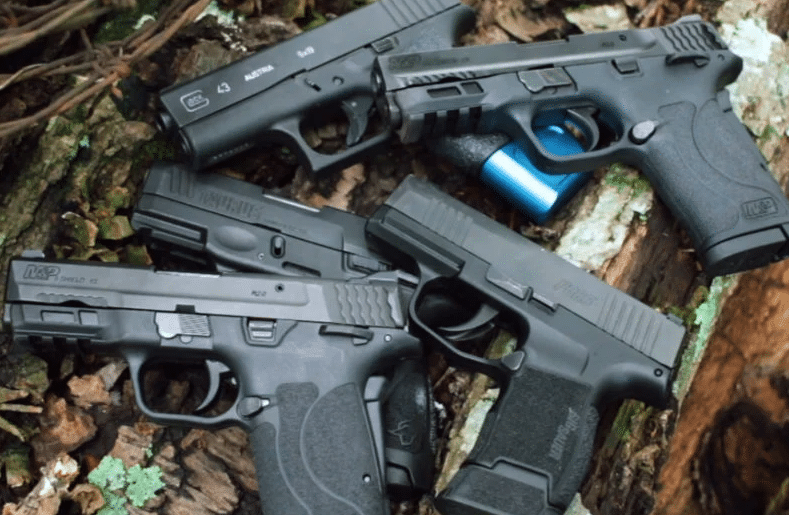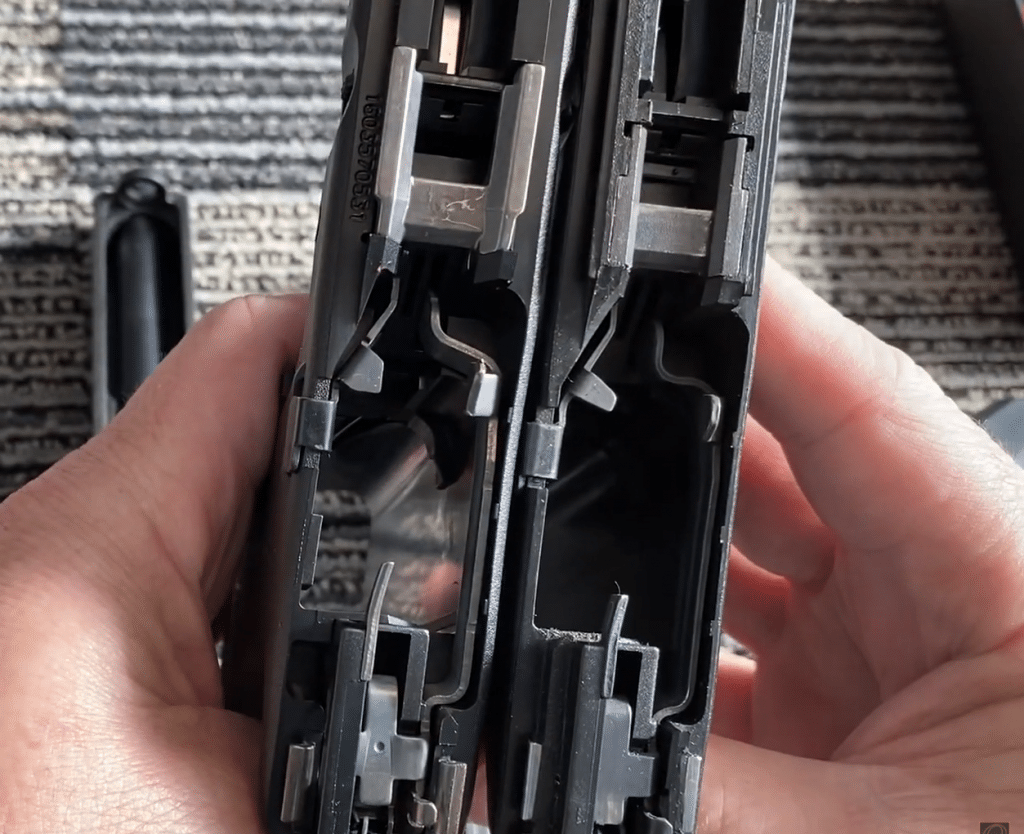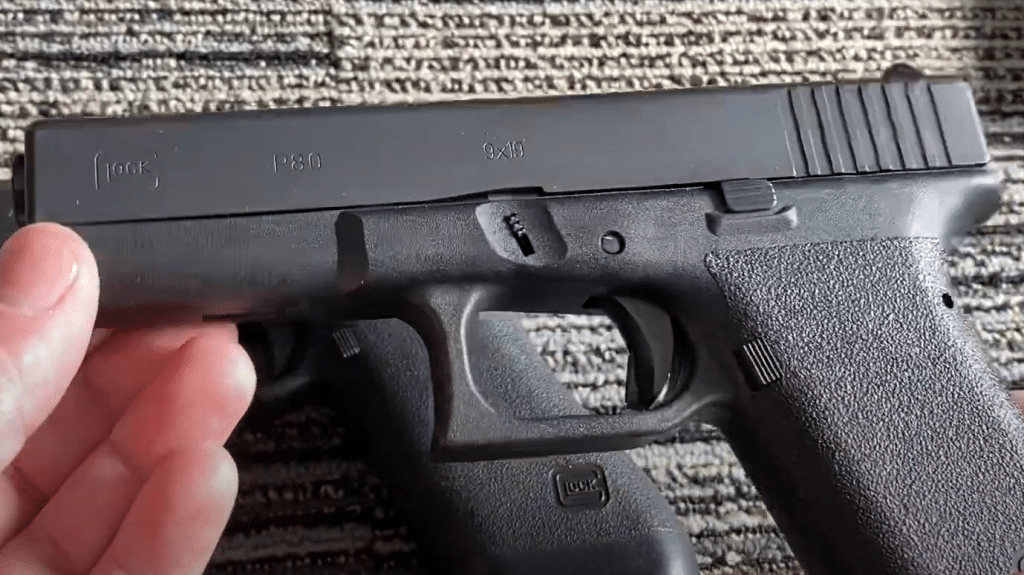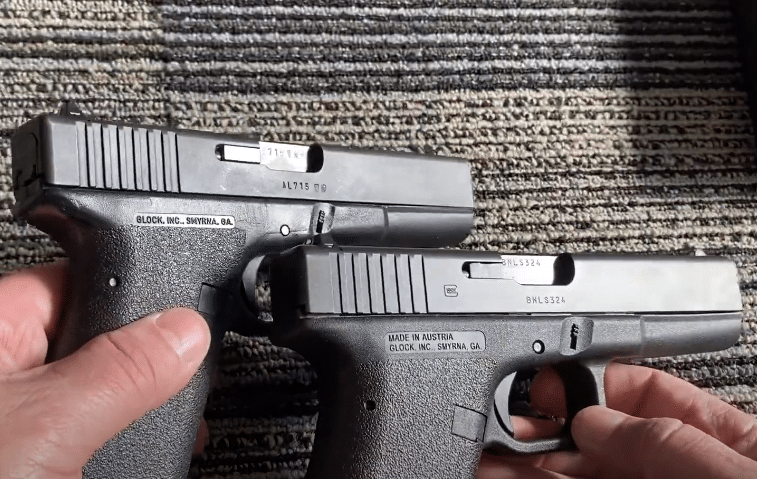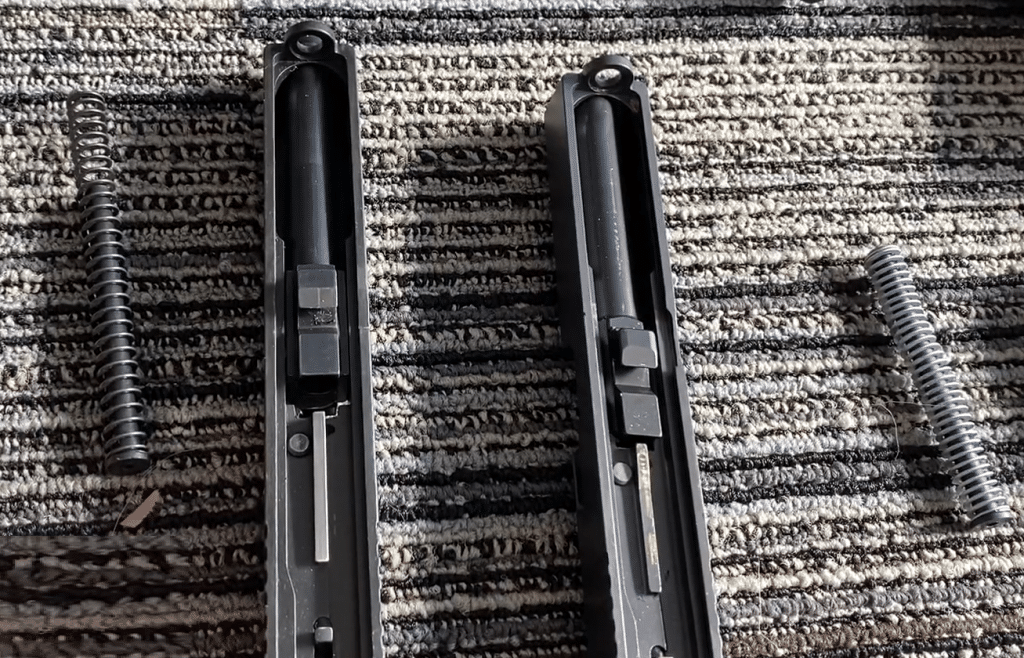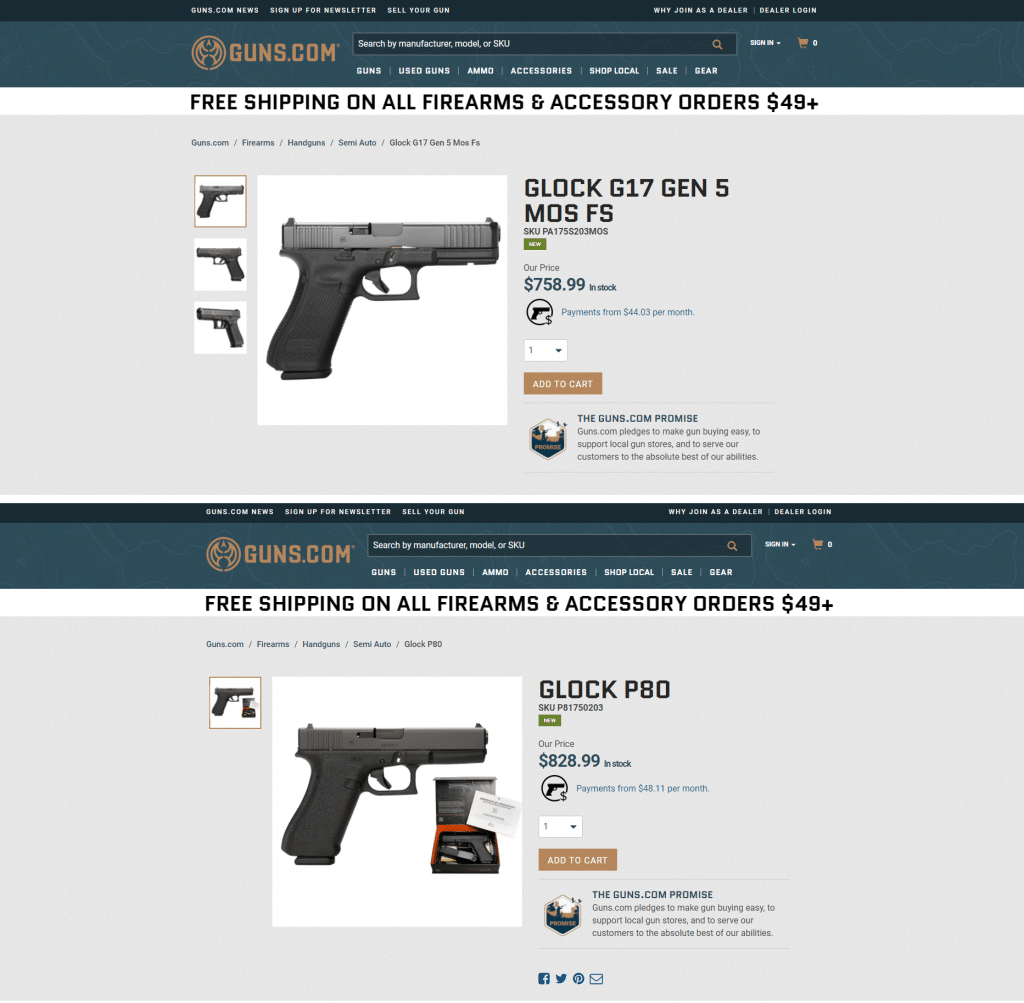>About a year ago, Lipsey’s, in collaboration with Glock Austria, released a remake of the first generation Glock 17 they labeled the P80. It looks like a faithful reproduction on paper.
>But as with most dead firearms that have been recently brought back from the grave (I’m looking at you, Colt, and your new Python), the question in everyone’s mind is, is the Glock P80 any good?
Table Of Contents
The OG – Original Glock 17
>The original Glock 17 certainly was — why, if it weren’t, the Austrian military wouldn’t have adopted it for service. It wouldn’t have started the whole plastic pistol revolution. The word “Glock” probably wouldn’t have become associated with lightweight, reliable polymer handguns. >Aluminum frame handguns> would still probably be the norm. There would be no Ruger LCRs, no S&W M&Ps, no Springfield XDs, nothing. You get the idea.
>So maybe you’re one of those who have heard of Lipsey’s P80 reproduction and you’re trying to do your due diligence before deciding on whether or not you should buy one. Or you could be a collector who has been itching to add a Glock 17 Gen 1 to your collection for the longest time but has never gotten around to buying one (because prices of the very few in mint condition from the 1980s are getting higher and higher as they become rarer).
>Or you’re probably just curious to know if it’s worth getting the new P80 over the >Glock 17 Gen 5>. Whichever the case may be, if you want to buy one but you’re on the fence, you’ve come to the right place. Stick around and maybe we can help you make a decision.
WHAT’S THE BIG DEAL WITH THE GLOCK 17 GEN 1?
>For those who don’t know its history, Gaston Glock designed and developed it as his first handgun back in the early 80s when the Austrian military was looking for a new service pistol to replace their World War II-era Walther P38s.
>It has to be noted that Gaston Glock had previously never made a single firearm. Sure, he had been manufacturing products for the Austrian military in the 1970s but those were mostly machine gun ammo belt links, knives, and grenade casings. No one would have thought he could come up with a design that would outdo all of its competing rivals in the Austrian military’s tests.
>Gaston designed his pistol to be simple to operate, highly reliable, and ready to fire at a moment’s notice. Those attributes meant that unlike the more popular military-adopted handguns before it, his pistol shouldn’t have external safeties (i.e like the 1911’s thumb and grip safeties) — rather, it would use internal trigger, firing pin, and drop safeties. Less moving parts meant a simpler, more reliable design that allowed for a faster transition between drawing and pulling the trigger.
>In addition, to meet other requirements set forth by the Austrian military, Gaston’s handgun had to have a consistent trigger pull, a hammer-forged polygonal barrel, a high-capacity magazine, and a lightweight frame made of polymer which, before the fact, had been practically unheard of. And yes, we’re aware of the existence of the H&K VP70, and that it came out before any Glock pistol — but it was too janky that no one wanted it, so it didn’t make polymer-framed firearms popular.
>As a businessman, Gaston had a lot of experience with industrial polymers, so it was only logical for him to use that experience to make his first firearm lightweight in a unique way. Once its development was complete, Gaston procured a patent for it — the 17th that his company had had at the time — and so he christened it the Glock 17.
>The Austrian military favored his submission more than all the others’ and adopted it as their new service pistol, formally naming it the P80. Whether that historic event was in 1982 or 1983 is anybody’s guess (>it depends on who you talk to>). Not too long after, NATO subjected the Glock 17 to their durability test and it passed, making the Norwegian military also adopt it as their service pistol. Glock’s popularity then started to skyrocket all over the world.
>Gaston opened his company in the US in 1986. He made more polymer handguns in different sizes chambered in varying handgun calibers, and everyone loved them. Long story short, the use of polymers in firearms would become the norm in the past couple of decades, dominating both the civilian and military/law enforcement markets. And Gaston would end up becoming a billionaire. All thanks to the Glock 17.
IS LIPSEY’S P80 REMAKE ANY GOOD?
>The TL;DR of this section is, it’s not just good, it’s even better than the original Glock 17 Gen 1. Considering that Glock doesn’t have the original molds they used for the Gen 1 Glock 17 frames and they had to recreate those so that the resulting frames would be the exact same up to the last millimeter dimensions-wise, they really outdid themselves with this remake.
>But before you even ask if the new P80 is an exact copy of its forerunner, we’d like to tell you now that it isn’t. Glock took the liberty of applying some changes and from what we can tell, everything was done just right. This new P80 is about 95% faithful to the original, both internally and externally. Again, considering the challenges Glock faced with its production, that is nothing short of outstanding.
ELEMENTS THAT STUCK AROUND
>Like the original, the new P80’s grip has no finger grooves. But it has what people commonly refer to as the pebble texture that wraps all around the grip. Similarly, the trigger guard has that same pebble texture too.
>I personally don’t care too much for it because I have sweaty hands and it can slip easily unless I put on some gloves. I prefer Gen 4 and Gen 5 grip textures that allow for a more solid purchase. But if you’ve held a Gen 1 Glock 17 before and you liked the way it felt in your hands, then you will like the new P80’s grip as well.
>As far as slide features, like the Gen 1 Glock 17, the new P80 has no front slide serrations. Its frame also has no rail for attachments. These sound like a dealbreaker but if you want them, you should opt for at least a Gen 3 or any newer generation Glock.
>Similarly, the new P80 has retained Gaston’s original single pin design. Glock only started >adding another pin to Gen 3 models>, the earlier ones being those chambered for the .40 S&W but to save on manufacturing costs, they eventually added the second pin to models chambered for the 9mm as well. Since both the Glock 17 and the P80 are chambered for the 9mm, they don’t need a second pin — the same way that Gen 5 Glocks only use a single pin as they’re all chambered only for the 9mm.
>The flat extractor on the old Gen 1 Glock 17s also made a comeback. Just like the one used in the original, the P80 remake’s extractor doesn’t have the hump on it that acts as a loaded chamber indicator (unlike the extractor on Gen 4 Glocks).
>Perhaps one of the not-so-notable features of the Glock 17 Gen 1 that stayed with the P80 reproduction (as with all other Glock pistols) is the polygonal barrel rifling. This is a broad subject that deserves its own write-up so we wouldn’t bore you with the details, but suffice it to say polygonal barrel rifling allows for higher bullet velocities at the expense of limiting the user’s ammo choices (this is why >you can’t shoot lead bullets> out of any Glock).
>And finally, as with the original, the new P80 retained its very tiny magazine release and that cut-out on the bottom front of the grip for grabbing the magazine, which everyone hates (more info on it below).
DIFFERENCES BETWEEN THE GLOCK 17 GEN 1 AND THE P80 REMAKE
>The P80 is still 5% inaccurate though as far as reproductions go. Would it hugely affect you if you were to buy a P80 remake now? We don’t believe so. The inaccuracies primarily have to do with the magazines included and minute dimensional changes on the frame, the markings, the recoil spring, and the guide rod. The different slide finish used in either models isn’t really worth discussing, as nobody ever really wins the >Tenifer vs. nDLC finish debate>.
>Starting with the magazine, original P80 magazines didn’t have any steel lining on the inside so whenever it was loaded with 17 rounds, it would swell. Pushing the magazine release button wouldn’t let it drop freely, which is why there’s a cut-out on the bottom front of the original version’s grip — it’s for when the user needs to manually pull a swollen magazine out.
>The ones included with the P80 remake are the steel-lined Gen 4 magazines complete with the ambi cut-outs. These are considerably more durable than the original magazines and don’t swell when loaded full, so there isn’t really a need to add that cut-out on the bottom front of the grip — they just put it there for aesthetics.
>Looking at the frame, the new P80’s takedown lever recess is just a little bit wider than the old P80’s. Glock probably made it this way to make field stripping the newer versions a little bit easier for people with thicker thumbs. Similarly, the pinhole on the new P80’s frame is ever so slightly wider than the one on the old P80 such that when you look at them side by side, the trigger pin in the new P80 looks a bit recessed while the trigger pin in the old P80 looks flush with the frame.
>As far as markings, if you’re a collector and every bit of aesthetic detail means a lot to you, the new P80 might not interest you much as the old one because the new P80 has a “MADE IN AUSTRIA” added to the original’s “GLOCK, INC. SMYRNA, GA” on the frame. Similarly, the slide markings on the P80 remake look cleaner as they’re laser-etched, whereas the factory markings on the old Glock 17 Gen 1 have deeper cuts that still look good aesthetically but are nowhere near as clean as the ones on the remake.
>Onto the recoil spring and guide rod. The new P80 has a guide-rod-spring assembly that uses a single captive spring (similar to the dual captive spring in Gen 4 pistols). The Glock 17 Gen 1 used a guide rod with a spring that could be freely pulled out. I’m of the opinion that the original non-captive spring is better because I like tinkering with my handguns and trying hot loads.
>A non-captive recoil spring assembly will allow you to easily remove the factory spring and replace it with a lighter or heavier aftermarket spring. It will also allow you to easily replace the factory guide rod with either a steel or a titanium one for better muzzle flip/recoil management especially when shooting hot loads.
>But that’s just me. If you only shoot factory loads and don’t care about all the hot stuff Buffalo Bore and Underwood sell, you’ll be fine with the captive recoil spring assembly in the new P80.
ANY GOTCHAS TO BE AWARE OF THE P80?
>Besides the differences we mentioned, there doesn’t appear to be any reason for you not to buy a Lipsey’s P80 remake — if you really want one. Again, it’s not a 100% complete reproduction, but as far as reproduction firearms go in general, you’d be hard-pressed to find one as close to its original counterpart as it is.
>If I’m being honest though, I personally don’t like this remake. The reason is, first, I’m not a Glock guy. I’m more of a 1911 and big bore revolvers kind of guy. And second, I don’t understand how the new P80 is any better than a Gen 5 Glock 17 (or even a Gen 3 or Gen 4). The Gen 5 is objectively the superior handgun with all its newer generation features, and yet, it’s selling for lower than the P80 remake at the time of this writing.
>Guns.com has >NIB Gen 5 Glock 17s> selling for only $758.99 while their >NIB Lipsey’s Glock P80s> is listed for $828.99. It just doesn’t make sense. The rail on the Gen 5 alone makes it infinitely better, and don’t even get me started on its grip texture. I can shoot a Gen 5 all day without gloves on. I can’t say the same thing about this P80.
>But let’s say you’re a collector, you’re only in it for novelty’s sake and you don’t see yourself shooting more than a couple of boxes of factory ammo in it every year, should you avoid it? I’d say it would depend on how badly you’ve been bitten by the new P80 bug. Used Glock 17 Gen 1s are getting rarer and rarer that they now cost an arm and a leg. If you feel like you really have to have this new P80, for $828.99 it’s not a bad deal.
P80 Glock Reproduction Conclusion
>Don’t make my opinion stop you from getting one. It’s a really good reproduction of the plastic handgun that started it all, manufactured by the exact same company that made the original. And it is not a replica, it’s an actual serviceable piece of equipment for self-defense. If you ever get in a situation where your life is being threatened and this new P80 is all you have, you can depend on it — it should be as reliable and as durable as any other Glock pistol so you can’t go wrong with it.



